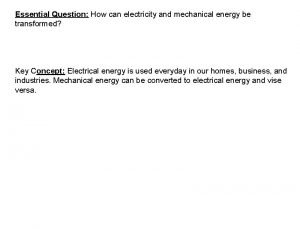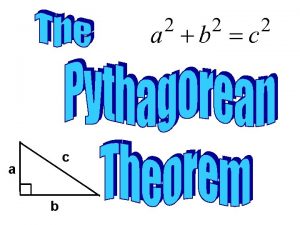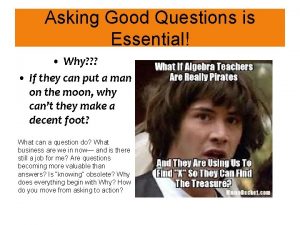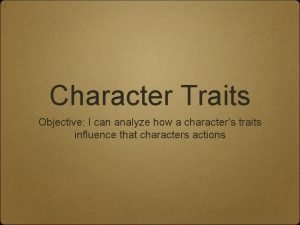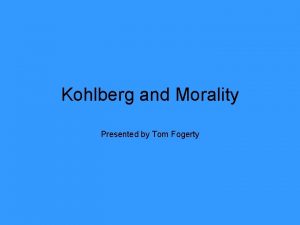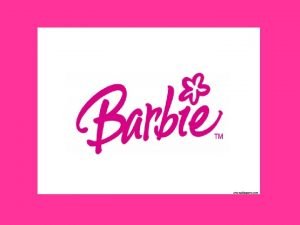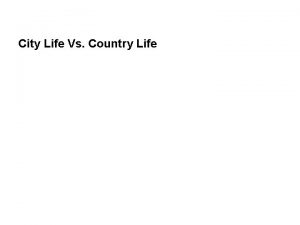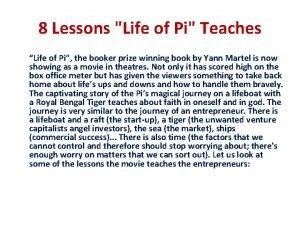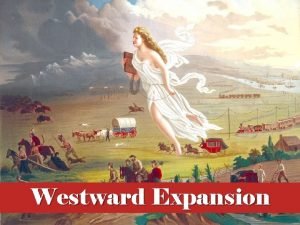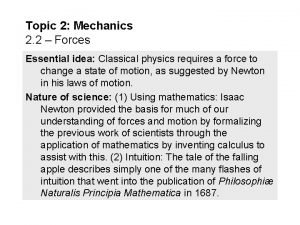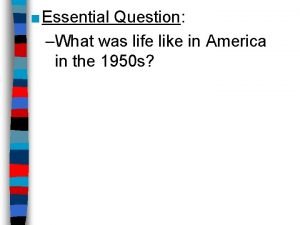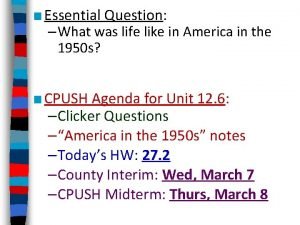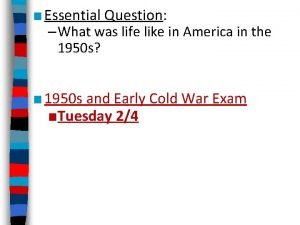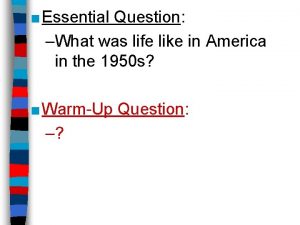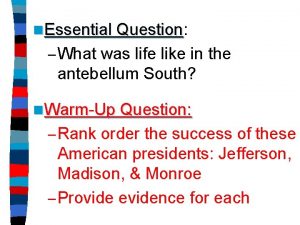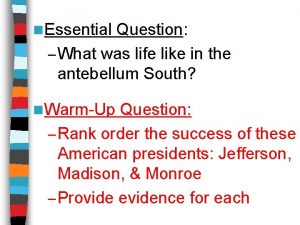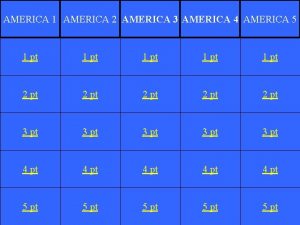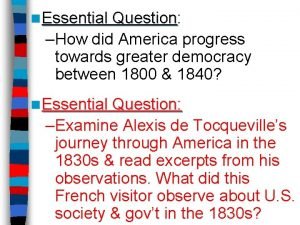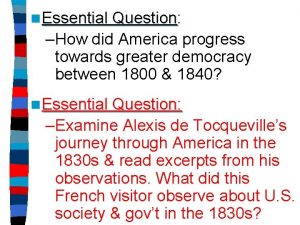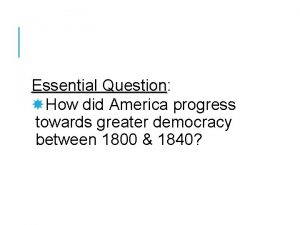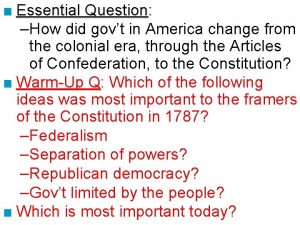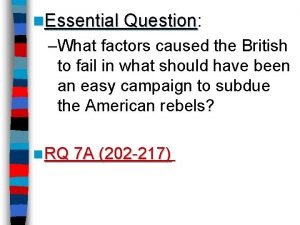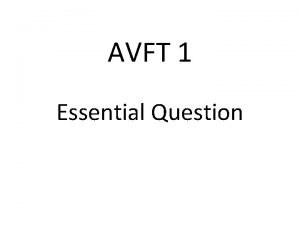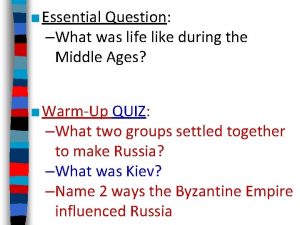Essential Question What was life like in America


































































- Slides: 66

■ Essential Question: –What was life like in America in the 1950 s? ■ Reading Quiz Ch 27 A

The 1950 s: The Affluent Society ■ The end of WWII led to an era of wealth & spending in the 1950 s: –The war stimulated the economy & ended the Great Depression –High wages, service pay for soldiers, & war bond investments gave Americans money to spend –The economic boom allowed Americans to enjoy the highest standard of living in the world

Watch the video & identify 3 ways America changed in the 1950 s

The 1950 s: Consumerism ■ Consumerism returned in the 1950 s –People rushed to buy new goods the&1 st time since the 1920 s, like. For TVs hi-fi record players Americans had access to cheap –Credit became available (The 1 st electrical appliances & cars credit card was created in 1950) –Advertisers used newspaper ads, radio, & new TV commercials to market goods to Americans –Franchises offered people across the country the same products

The “Affluent Society”

Consumerism Video

The 1950 s: The Baby Boom ■ Americans produced a “baby boom” in the 1950 s, leading to the largest generation in U. S. history –The return of soldiers from war led to an increase in marriages & a rise in the birthrate –The baby boom led to a demand for new baby products, schools, & homes for growing families

U. S. Birthrate, 1940 -1970 The late 1940 s & 1950 s experienced the “baby boom” In 1957, a baby was born every 7 seconds

The 1950 s: Suburbs ■ Suburbs boomed in the 1950 s: –The majority of Americans worked in cities but wanted the security of suburbs for their families –Suburbs offered peace of mind, affordable homes, & good schools –The GI Bill of Rights offered returning soldiers cheap loans for new homes & tuition for college


The desire for homes in the suburbs led to communities like Levittown in NY • massive 1 story high IN POPULATION • 12’x 19’SHIFTS living room DISTRIBUTION, • 2 bedrooms 1940 -1970 • tiled bathroom 1940 • garage Cities 31. 6% Suburbs 19. 5% • small backyard Rural Areas 48. 9% • front lawn 1950 32. 3% 23. 8% 43. 9% 1960 32. 6% 30. 7% 36. 7%

The 1950 s: Suburbs ■ Suburbs changed American life: –Suburbs increased America’s need for cars & highways –Churches, schools, grocery stores, & shopping centers were build to service the suburbs –But, the migration to the suburbs was mostly by white families; “White flight” to the suburbs left African Americans in urban areas

Southdale Shopping Center, Minnesota— the 1 st enclosed, air-conditioned shopping mall

The Economy, Suburbs, & Baby Boom

The 1950 s: Automania ■ In the 1950 s, Americans bought cars in record numbers: –The growth of suburbs, creative advertising, easy credit, & cheap gasoline led to a car boom –Congress added 41, 000 miles of expressway when the Interstate Highway Act was passed in 1956 –Automobile companies made big, powerful, flashy cars



“Automania” transformed Americans were mobile, took long-distance vacations, & lived further from their jobs

“Automania” transformed America Cars led to drive-thru restaurants & drive-in movies

Watch the video & identify 3 way America changed in the 1950 s

The 1950 s: Popular Culture ■ Americans in the 1950 s enjoyed new forms of entertainment: –Television boomed as Americans watched comedies, news reports, westerns, & variety shows –TV ownership jumped from 9% in 1950 to 90% by 1960 (45 million) –Businesses took advantage of TV to advertise goods to buyers

Television in the 1950 s TV Dinners

“I Love Lucy” TV Show

The 1950 s: Popular Culture ■ Music changed in the 1950 s: –“Doo-wop” music dominated the early 1950 s, but, was challenged in popularity by rock n’ roll –Rock ‘n’ roll music was inspired by black artists, but Elvis Presley made it popular among the youth –Rock scared parents who thought the fast beats were immoral


This rock ‘n’ roll music is a SIN!

Doo-Wop

Rock ‘n’ Roll

Teenagers were an important force in the 1950 s Suburban teens had leisure time & money to spend

Teenagers were an important force in the 1950 s Businesses targeted teenagers, selling billions of dollars of “cool” consumer goods

Hollywood movies targeted teens & made films about “juvenile delinquency”

The 1950 s: Conformity ■ TV, movies, & advertising in the 1950 s promoted conformity & stereotypes The “ideal woman” was a housewife & mother

The 1950 s: Conformity ■ TV, movies, & advertising in the 1950 s promoted conformity & stereotypes The “ideal man” was provider & boss of the house

The 1950 s: Conformity ■ TV, movies, & advertising in the 1950 s promoted conformity & stereotypes Changing Sexual Behavior: Behavioral Rules of the 1950 s: § Sexologist Alfred Kinsey revealed § Obeythat: authority. § Premarital sex was § Control Your emotions. common § Fit in with affairs the crowd. § Extramarital were frequent among § Don’t even think about sex!!! married couples But, stereotypes were not accurate of most Americans

The 1950 s: Conformity ■ The “beat movement” rejected conformity: –“Beatniks” were artists & writers who lived non-conformist lives –Rejected suburbs, consumer goods, & “regular jobs” –Led by Jack Kerouac, the beats inspired the “hippies” of the 1960 s

Littlethe And they boxes people boys all on play gothe ininto on the hillside, the business, houses golf-course, Little All And went drink marry, boxes totheir the and made university, Martinis raise of ticky-tacky, a family, dry, Little Where And In boxes they made all on were have of theticky-tacky pretty put hillside, in boxes, children, Littlethey And the boxes, children came all look all the out go just same. all tothe school. same. And the There's there's achildren green pink doctors one goand to andsummer a lawyers agreen pink one camp And athen business bluetoone the executives, and university, a yellow one Where And they're they all aremade put inout boxes of ticky-tacky And they all come lookout just the same.

The 1950 s: Social Groups ■ The 1950 s had an important impact on women: –The media promoted women as mothers & homemakers, but almost 40% of mothers had jobs – 20% of suburban women reported being dissatisfied, isolated, bored –Working women were limited to nursing, teaching, clerical jobs

The 1950 s: Social Groups ■ African American civil rights leaders began to challenge segregation laws –In 1947, Jackie Robinson integrated professional baseball –In 1954, in Brown v Board of Education, the Supreme Court integrated public schools –In 1955, Martin Luther King, Jr. emerged as the leader of the civil rights movement

The Beginning of Civil Rights in the 1950 s

President Eisenhower’s Modern Republicanism

Eisenhower’s Modern Republicanism ■ Frustration with the stalemate in Korea & the Red Scare led to a Gov’t Korean War Communism Republican presidential takeover Corruption in the 1952 ■ WW 2 hero Dwight Eisenhower for “K 1 C 2” Onceprovided elected, Ikean didantidote go to Korea, overturned the U. N. battle plan, &Nixon threatened China with –VP Richard attacked nuclear war to get an armistice signed in 1953 communism & corruption –Eisenhower vowed to go to Korea & personally end the war

Eisenhower’s Modern Republicanism “I’m conservative when it comes to money ■ Eisenhower politics and liberal when itlabeled comes to his human beings” “Modern Republicanism”: –“Ike” believed in conservative gov’t spending & a balanced budget but he had no desire to end New Deal programs –The affluent, postwar “good life” at home was dependent upon a strong Cold War foreign policy

Eisenhower’s Modern Republicanism During the Eisenhower era, the U. S. economy avoided inflation & brought middle■ In spiraling his 8 years as president, Ike class a prosperity more Americans had modesttodomestic record: –Instead of ending New Deal programs, Eisenhower added to social security & minimum wage –Helped finance building & purchasing of suburban homes –Created the Depts of Health, Education, & Welfare –Interstate Highway Act of 1956 added 41, 000 miles of road

Eisenhower’s Modern Republicanism ■ Interstate Highway System: System –Highway Act of 1956 created 41, 000 miles of divided highway to connect major U. S. cities –These highways helped promote national defense, interstate trade, & vacation travel –All funds were raised exclusively through gas, tire, & car taxes

The Republicans “Have you no decency, Mr. Mc. Carthy? ” in Power ■ Regarding Mc. Carthyism, Ike provided Mc. Carthy “just enough rope to hang himself” in 1954 –In the televised “Army hearings, ” “I am not going to get into a [peeing] contest with a skunk” the nation saw Mc. Carthy’s style & fact-less attacks –The Senate censured Mc. Carthy & his “communist” attacks quickly died


■ Essential Question: Question –How do the domestic & foreign policies of Truman & Eisenhower compare? ■ Reading Quiz Ch 27 B

Eisenhower & the Cold War ■ In 1952, World War II hero Dwight Eisenhower was elected president –At home, he tried to promote the “good times” of the 1950 s economic boom –In foreign policy, he took a strong stand against Communism Eisenhower video

Eisenhower’s New Look Foreign Policy Video (4. 33)

Brinksmanship ■ Eisenhower began a “New Look” to fight the Cold War: –He invested heavily in new longrange nuclear missiles (ICBMs) –In foreign policy, he used veiled threats of nuclear war to achieve his goals (called brinksmanship) –In case of a Soviet attack, the U. S. would use “massive retaliation” thus making the use of nuclear weapons unlikely on either side

Nuclear submarines The stockpiling of ICBMs

What are the stakes of war? Massive Retaliation? Mutual Assured Destruction?

Americans were anxious by the threat of nuclear war & built fallout shelters for protection

Fallout Shelter Commercial (0. 38)

Eisenhower & the Cold War ■ In response to the threat of a Soviet nuclear attack, Eisenhower pushed Congress to create the Interstate Highway System in 1956 – 41, 000 miles of divided highway to connect major U. S. cities –In addition to helping promote trade & travel, these highways were vital to evacuate cities during a nuclear attack

Interstate Highway System

The Eisenhower Doctrine ■ After Stalin’s death in 1953, new Soviet leader Nikita Khrushchev began to challenge U. S. influence: –In 1955, the USSR formed the Warsaw Pact alliance

Chinese Massive did not know. Retaliation if Ike was bluffing so backed off this territorial expansion ■ In. China 1954, Eisenhower used a hard -line approach to stop Chinese expansion in Asia: …and – the refusal of the USSR to aid China added a Chinese attempts to take over rift between Russia & China by the end of the 1950 s islands near Taiwan led Eisenhower to threaten nuclear war if China did not stop –Eisenhower hoped this pressure would drive a wedge between the USSR & communist China

Massive Retaliation ■ In 1956, Egyptian leader Nasser nationalized the start Suez Canal: we “If those fellows something, have to&hit. France ‘em—and, if necessary, –may England invaded Egypt with everything in the bucket” to take back the canal but the USSR opposed this intervention –Eisenhower did not want the USSR to attack so he threatened Russia with nuclear war –England, France, & the USSR left Egypt & the U. S. became the leader in Middle East

Eisenhower Doctrine Like the Monroe Doctrine in Latin America, ■ The Suez Crisis revealed thepower the United States emerged as a police vulnerability of the Middle in a new part of the world East to Communism & Ike responded: –In 1957, the Eisenhower Doctrine recommended U. S. armed forces to protect the Middle East from Communist aggression –In 1957, Ike sent the military to Lebanon to halt Communism & install a pro-Western gov’t

Covert Actions ■ Ike’s administration used covert CIA acts to expand U. S. control: “The the end justifies the means” –In 1953, CIA overthrew Mohammed Mossadegh in Iran in favor of a U. S. -friendly shah –Ininterventions 1954, the led CIAtooverthrew a These anti-American leftist Guatemala hostilities in theregime Middle in East & Latin America –In 1959, the CIA took a hard-line against new Cuban dictator Fidel Castro after his coup

Sputnik & the Space Race ■ In 1957, the USSR launched the 1 st space satellite, Sputnik I –People feared that the U. S. had lost its competitive edge –The National Aeronautics & Space Advanced placement (AP) classes Administration formed were created as a(NASA) result ofwas the NDEA in 1958 to catch up to the Soviets –National Defense Education Act was created to promote math, science, & technology education

The “space race” intensified the The Original Seven NASA Mercury Astronauts Cold War between USA & USSR

Eisenhower & the Cold War ■ Eisenhower failed to thaw the Cold War by the end of the 1950 s: –In 1960, an American U-2 plane was shot down over the USSR proving we were spying on Russia –He was unable to negotiate with the USSR weapons reduction –Before leaving office, he warned against overspending on defense (“Military Industrial Complex”)

U. S. and USSR nuclear stockpiles Francis Gary Powers & the U-2 Incident

Conclusions ■ By 1960, the American people were more optimistic than in 1950 –Americans were no longer afraid of a return of another Great Depression –Anxiety over the Cold War continued but was not as severe –But, American values & race relations were areas of concern
 Costa level 3 questions examples
Costa level 3 questions examples Essential non essential fatty acids
Essential non essential fatty acids Rap of the map of the us
Rap of the map of the us Europe vs asia
Europe vs asia Repetition in let america be america again
Repetition in let america be america again Why called latin america
Why called latin america Happening e performance
Happening e performance Who is the author
Who is the author Pythagorean theorem essential questions
Pythagorean theorem essential questions Essential question generator
Essential question generator Essential question for pythagorean theorem
Essential question for pythagorean theorem Language
Language Essential question about identity
Essential question about identity Essential context clues
Essential context clues Cornell notes essential question
Cornell notes essential question What makes a question essential
What makes a question essential Essential questions for multiplication
Essential questions for multiplication Essential question gif
Essential question gif Internal character traits
Internal character traits Cornell way
Cornell way Essential questions for short story unit
Essential questions for short story unit 25 elements essential to life
25 elements essential to life Questions without question words
Questions without question words Closed questions
Closed questions Contoh open ended question
Contoh open ended question Factor-isolating questions vs. factor-relating questions
Factor-isolating questions vs. factor-relating questions Question direct
Question direct What are supporting questions
What are supporting questions Compelling question example
Compelling question example Prefer and would rather grammar
Prefer and would rather grammar Remo university of alberta
Remo university of alberta Which features of the sun look like huge cloudlike arches
Which features of the sun look like huge cloudlike arches Why does ethanol look like water but behave more like wood?
Why does ethanol look like water but behave more like wood? Like minds like mine
Like minds like mine What he looks like or how he looks like
What he looks like or how he looks like What he looks like or how he looks like
What he looks like or how he looks like I like the flowers boomwhackers
I like the flowers boomwhackers Language
Language Which is worse stealing like karl or cheating like bob
Which is worse stealing like karl or cheating like bob Like father like son in italian
Like father like son in italian Let life be beautiful like summer flowers
Let life be beautiful like summer flowers What was life like for the jews in greek-ruled lands
What was life like for the jews in greek-ruled lands Red flag feeling social media
Red flag feeling social media My life is like a storybook story
My life is like a storybook story Ode to la tortilla answers
Ode to la tortilla answers What does barbie look like in real life
What does barbie look like in real life Vocabulary city life
Vocabulary city life Farm life vs city life
Farm life vs city life Example of polynomial in real life
Example of polynomial in real life Single life and married life
Single life and married life Difference between life skills and life orientation
Difference between life skills and life orientation Country life vs city life compare /contrast
Country life vs city life compare /contrast City life vs country life
City life vs country life What does life of pi teach us
What does life of pi teach us Boundaries meme
Boundaries meme Life that is truly life
Life that is truly life John needham experiment main idea
John needham experiment main idea Unit 8 country life and city life
Unit 8 country life and city life How did the hudson river school increase westward expansion
How did the hudson river school increase westward expansion Essential clothing
Essential clothing Essential unified process
Essential unified process Laws of friction
Laws of friction The webinar will begin shortly
The webinar will begin shortly What are the 6 essential elements of geography
What are the 6 essential elements of geography Interdependence
Interdependence Renaissance trade map
Renaissance trade map Using math to define the foodservice industry
Using math to define the foodservice industry









